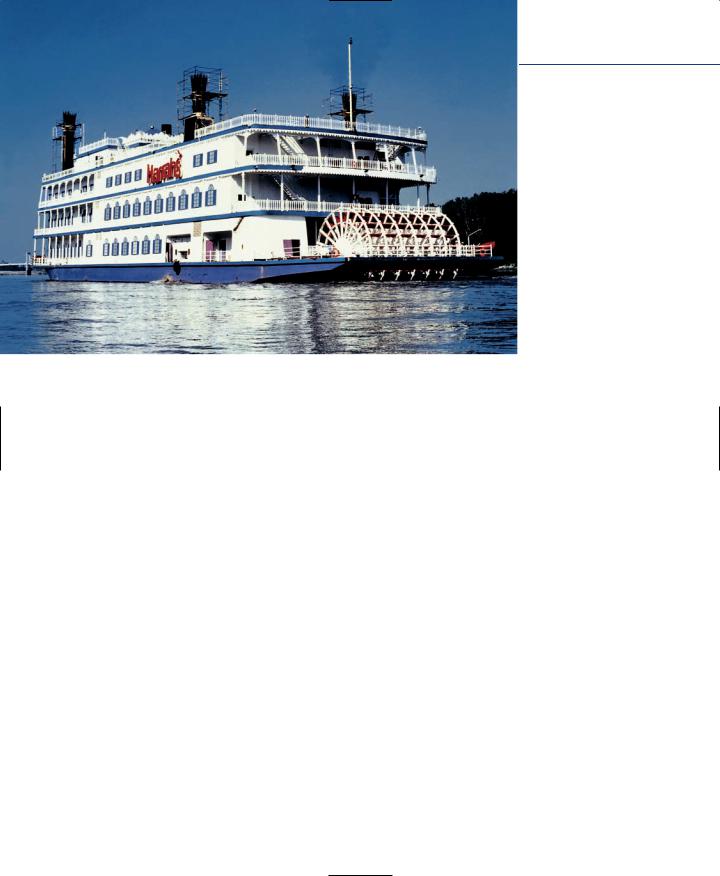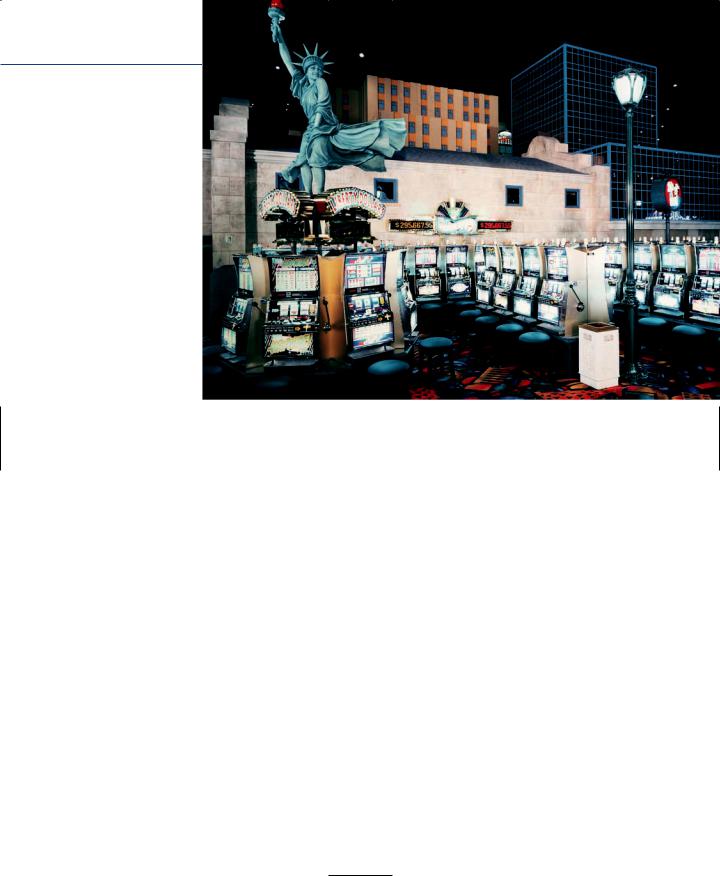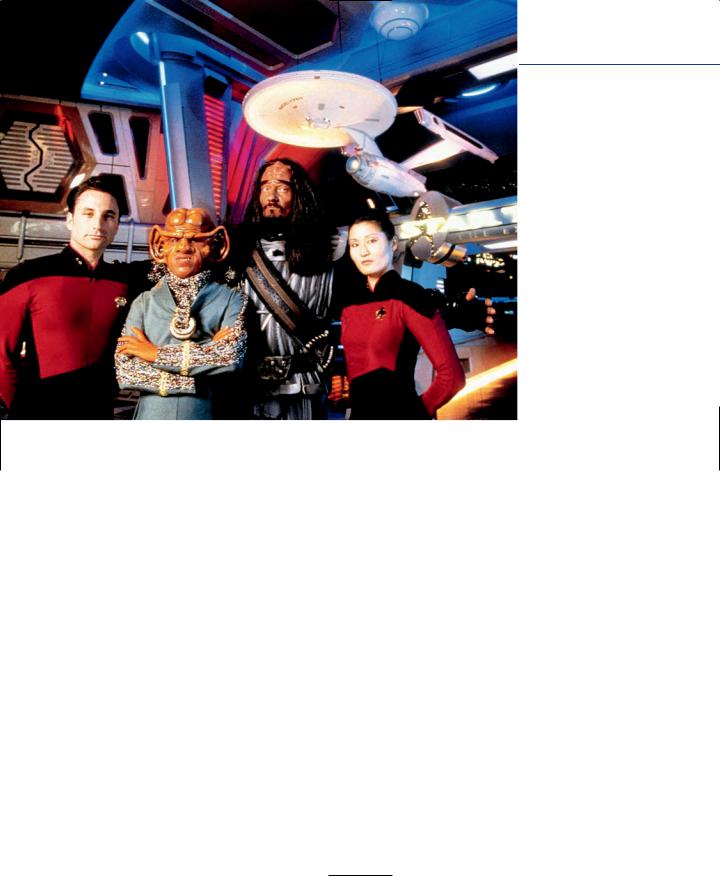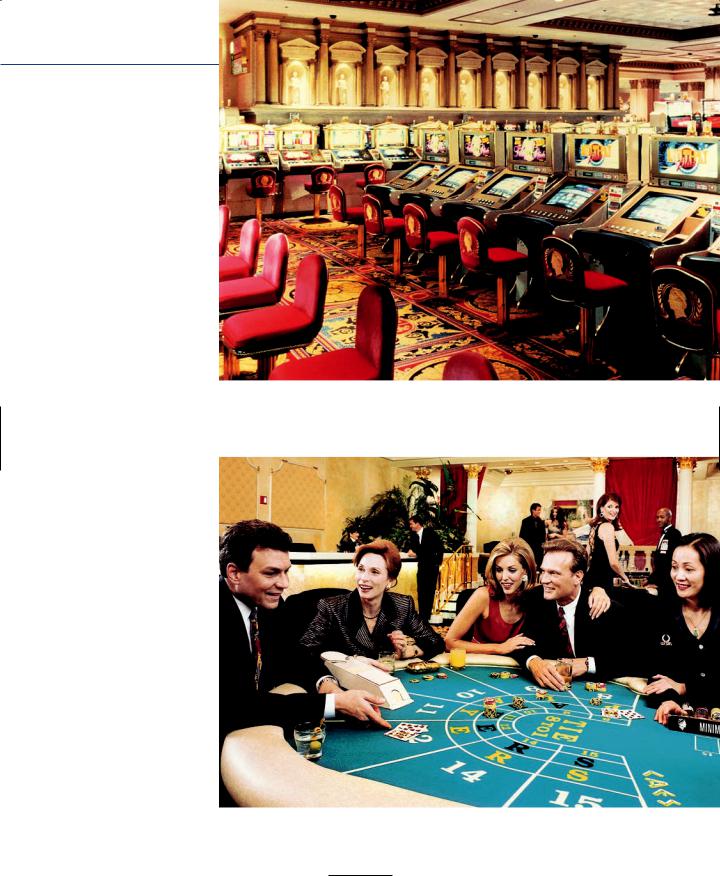
- •CONTENTS
- •PREFACE
- •Content—Benefits for Students
- •Content—Benefits for Instructors
- •Features of the Book for Students and Instructors
- •Supplementary Materials
- •Acknowledgments
- •What Is Hospitality Management?
- •The Manager’s Role in the Hospitality Industry
- •Why Study in a Hospitality Management Program?
- •Planning a Career
- •Employment as an Important Part of Your Education
- •Getting a Job
- •Employment at Graduation
- •The Outlook for Hospitality
- •Summary
- •Managing Change
- •Demand
- •Supply
- •Workforce Diversity
- •The Impact of Labor Scarcity
- •Summary
- •The Varied Field of Food Service
- •The Restaurant Business
- •The Dining Market and the Eating Market
- •Contemporary Popular-Priced Restaurants
- •Restaurants as Part of a Larger Business
- •Summary
- •Restaurant Operations
- •Making a Profit in Food Service Operations
- •Life in the Restaurant Business
- •Summary
- •Chain Restaurant Systems
- •Independent Restaurants
- •Franchised Restaurants
- •Summary
- •Competitive Conditions in Food Service
- •The Marketing Mix
- •Competition with Other Industries
- •Summary
- •Self-Operated Facilities
- •Managed-Services Companies
- •Business and Industry Food Service
- •College and University Food Service
- •Health Care Food Service
- •School and Community Food Service
- •Other Segments
- •Vending
- •Summary
- •Consumer Concerns
- •Food Service and the Environment
- •Technology
- •Summary
- •The Evolution of Lodging
- •Classifications of Hotel Properties
- •Types of Travelers
- •Anticipating Guest Needs in Providing Hospitality Service
- •Service, Service, Service
- •Summary
- •Major Functional Departments
- •The Rooms Side of the House
- •Hotel Food and Beverage Operations
- •Staff and Support Departments
- •Income and Expense Patterns and Control
- •Entry Ports and Careers
- •Summary
- •The Economics of the Hotel Business
- •Dimensions of the Hotel Investment Decision
- •Summary
- •The Conditions of Competition
- •The Marketing Mix in Lodging
- •Product in a Segmented Market
- •Price and Pricing Tactics
- •Place—and Places
- •Promotion: Marketing Communication
- •Summary
- •The Importance of Tourism
- •Travel Trends
- •The Economic Significance of Tourism
- •The United States as an International Tourist Attraction
- •Businesses Serving the Traveler
- •Noneconomic Effects of Tourism
- •Summary
- •Motives and Destinations
- •Mass-Market Tourism
- •Planned Play Environments
- •Casinos and Gaming
- •Urban Entertainment Centers
- •Temporary Attractions: Fairs and Festivals
- •Natural Environments
- •On a Lighter Note. . .
- •Summary
- •Management and Supervision
- •The Economizing Society
- •The Managerial Revolution
- •Management: A Dynamic Force in a Changing Industry
- •What Is Management?
- •Summary
- •Why Study Planning?
- •Planning in Organizations
- •Goal Setting
- •Planning in Operations
- •The Individual Worker as Planner
- •Long-Range Planning Tools
- •Summary
- •Authority: The Cement of Organizations
- •Departmentalization
- •Line and Staff
- •Issues in Organizing
- •Summary
- •Issues in Human-Resources Management
- •Fitting People to Jobs
- •Recruiting
- •Selection and Employment
- •Training
- •Retaining Employees
- •Staff Planning
- •Summary
- •The Importance of Control
- •Control and the “Cybernetic Loop”
- •Tools for Control
- •Summary
- •Leadership as Viewed by Social Scientists
- •Why People Follow
- •Leadership Theories
- •Communication
- •The Elements of Leading and Directing
- •Developing Your Own Leadership Style
- •Summary
- •A Study of Service
- •Rendering Personal Service
- •Managing the Service Transaction
- •How Companies Organize for Service
- •Summary
- •INDEX

464Chapter 14 Destinations: Tourism Generators
3,500 seasonal employees but only 150 permanent employees. Few parks experience such employment swings, however. During the months when school is out or when outside weather conditions favor park visitation, attendance soars. As it does, food service volume (and demand for other support services) expands with it. Sometimes demand for these support services is quite large in proportion—Disney earns over 10 percent of its revenues from food service. In order to meet these peaks, the crew expands each summer. To supervise this expanded workforce, college-age people are chosen, usually from last year’s crew, as supervisors, assistant managers, and unit managers. These positions are often quite well paid, but more significantly, they offer a chance to assume responsible roles beyond those that most organizations offer to people early in their careers. Generally, these opportunities are accompanied by training and management development programs. Many of the supervisors and managers at LEGOLAND California, for instance, began their careers in summer jobs there and in entry-level positions such as ride operators.
The authors have graded more summer field-experience papers than we care to recall, and consistently some of the best opportunities and training experiences we have encountered have been in regional theme parks. Take a close look at the regional and local theme parks in your area as possible summer employers. They offer a type of hospitality experience different from what students might normally expect.
In conclusion, theme parks, both regional and national, represent one type of manmade environment available to travelers. They are increasingly popular, and the market is becoming increasingly competitive. This is only one type of such environments, however. Some very different types of tourist destinations are discussed next.
Casinos and Gaming
To move from the innocence of theme parks and country music to casinos and gaming may seem like a giant step, but they do have a good deal in common as tourism attractions—and they are becoming more similar all the time. Just note the many similarities that are now drawn between two tourist destinations: Las Vegas and Orlando. In fact, many aging baby boomers, who once brought their children to theme parks such as Disney World, are being lured to casinos and gaming destinations (in some cases, they continue to go to both). We will begin by looking at two quite different gaming markets: Las Vegas and Atlantic City. Also, a relatively newer gaming area, the Gulf Coast of Mississippi, will be presented. First, however, some discussion
of gambling in the United States is in order.
Gambling of all kinds has grown radically in the past decade. By 2007, 47 states and the District of Columbia had stateor city-operated lotteries, commercial casinos, or allowed charitable gaming. When all gaming opportunities are considered, it becomes

Casinos and Gaming |
465 |
clear that few jurisdictions are unable to offer their residents the possibility of a legal wager. According to the American Gaming Association, 25 percent of the adults visted a casino in 2005, allowing the industry to grow by 5 percent between 2004 and 2005 and gross $30 billion. This growth occurred despite the loss temporary loss of casino operations on the Mississippi Gulf Coast as a result of Hurricane Katrina.
The casino gambling environment is unique in that it combines the games usually associated with such operations with entertainment, food, and drink, lodging, and, increasingly, shopping. This makes it more of a total recreational experience, rather than a single, discrete activity conducted in isolation.
Casino gaming has exploded, driven by two developments in particular. The first of these was the Indian Gaming Regulatory Act of 1988, requiring that any kind of gambling that was permitted anywhere, at any time, in a U.S. state be per-
mitted on reservations in that state once a compact between the state and the Native American tribe had been concluded. In 2005, 224 federally recognized tribes offered some sort of gaming on their land. This represents a significant increase, up from 184 in 1998 and 81 in 1993. The facility that is generally believed to be the largest, as well as the most profitable, is the Mohegan Sun, the Mohegan Nation–owned facility in Uncasville, Connecticut (along with Foxwoods which is number two). In total, this segment of the gaming industry generated just under $23 billion in 2005. Sixty different Native American–run casinos had gaming revenues in excess of $100 million in the same year.3
The other relatively recent gaming development, modern riverboat gambling, did not come into being until 1991, when Iowa legalized the first gaming riverboat. There were 40 boats operating in 1994. In 2006, there were 83 boats in operation (some riverboats are really just casinos at the water’s edge) with total gaming revenues of over $10 billion. Riverboat gaming is most common in the Midwest and deep South. Analysts expect the riverboat gaming market to continue to grow, albeit at a slower rate with fewer new casinos opening.

Harrah’s operates this riverboat casino on the Missouri River in North Kansas City. (Courtesy of Harrah’s Casinos.)
Three primary forces appear to be driving the current growth in gaming. The first is a change in consumer tastes in which people have come to see gaming as a legitimate form of entertainment, rather than something that is done only by people of questionable background.
A second force that seems to be driving the industry is convenience. It is clear that the consumer’s propensity to gamble is influenced by proximity to a gaming facility. Couple this with the estimate that there is a gaming facility within a short distance from every urban area in the country. In short, most of the U.S. population is already within an easy day’s drive of a casino, and there are still many sites available for gaming, either on reservations or on riverboats.
A third force that explains why gambling is now so widely permitted is the intense need state and local governments have for funds. New gambling establishments are usually subject to a relatively high level of taxation because of the potential for profit. Gaming, in effect, is a voluntary tax. A high proportion of the drop (the total amount wagered) becomes win (winnings by the house), and a high proportion of the win is taxed by the state. Even in states that may not tax gaming facilities as much as others, “gifts” to the state may be made—and these “gifts” may often be in the tens of millions of dollars. It is important to recognize that as the many taxation and employment benefits to gaming are recognized by civic and business leaders in areas that have not as yet legalized gambling, there is a strong inducement to legalize it in new jurisdictions. Most recently, the state of Pennsylvania approved slot gaming in designated areas (and will issue 14 licenses). Figure 14.1 summarizes current gaming jurisdictions.
466

Casinos and Gaming |
467 |
|
C A S I N O S A N D G A M I N G |
||
|
L A N D - |
R I V E R B O A T / |
I N D I A N 1 |
|
B A S E D |
D O C K S I D E |
G A M I N G |
Arizona |
|
|
X |
California |
|
|
X |
Colorado |
X2 |
|
X |
Connecticut |
|
|
X |
Idaho |
|
|
X |
Illinois |
|
X |
|
Indiana |
|
X |
|
Iowa |
|
X |
X |
Kansas |
|
|
X |
Louisiana |
X |
X |
X |
Michigan |
X |
|
X |
Minnesota |
|
|
X |
Mississippi |
|
X |
X |
Missouri |
|
X |
|
Montana |
|
|
X |
Nebraska |
|
|
X |
Nevada |
X |
|
X |
New Jersey |
X |
|
|
New Mexico |
|
|
X |
New York |
|
|
X |
N. Carolina |
|
|
X |
N. Dakota |
|
|
X |
Oklahoma |
|
|
X |
Oregon |
|
|
X |
S. Dakota |
X2 |
|
X |
Washington |
|
|
X |
Wisconsin |
|
|
X |
Totals |
6 |
6 |
23 |
1Indicates only Class III Indian casinos
2Indicates limited stakes casinos
(Source: American Gaming Association, 2007.)
Figure 14.1
Current gaming jurisdictions with gaming operations.

468 |
Chapter 14 Destinations: Tourism Generators |
|
10,000 |
|
|
|
|
|
|
|
9000 |
|
|
|
|
|
|
|
8000 |
|
|
|
|
|
|
millions) |
7000 |
|
|
|
|
|
|
6000 |
|
|
|
|
|
|
|
5000 |
|
|
|
|
|
|
|
4000 |
|
|
|
|
|
|
|
(in |
|
|
|
|
|
|
|
3000 |
|
|
|
|
|
|
|
|
|
|
|
|
|
|
|
|
2000 |
|
|
|
|
|
|
|
1000 |
|
|
|
|
|
|
|
0 |
NJ |
MS |
LA |
IN |
IL |
MO |
|
NV |
 Gross revenues
Gross revenues 
 Tax revenues
Tax revenues
Figure 14.2
Gaming revenue of top seven states, 2002. (Source: American Gaming Association,
State of the States, 2003.)
An additional note needs to be made regarding the gaming jurisdictions as indicated in Figure 14.1. The figure would suggest that only 27 states offer casino gaming. In reality, many other states offer some form of legalized gambling aside from or in addition to lotteries. Horse races, video poker machines at truck stops, card houses, bingo halls, and offshore gambling are all available throughout the United States. The figure only includes land-based casinos, riverboats, and Class III Indian casinos. Figure 14.2 provides revenue figures for the different gaming jurisdictions.
LAS VEGAS
The first settlement in Las Vegas can be traced back to 1829, but the town’s formation dates from 1905, when it was a small desert railroad town. Casino gambling was legalized in 1931. Following World War II, Las Vegas grew more rapidly as large hotels were built, and by the 1950s, Las Vegas had become an established tourist destination combining casinos, superstar entertainment, and lavish hotel accommodations. Today, the Las Vegas metropolitan area has over 1.8 million residents and over 133,000 hotel and motel rooms—roughly one room for every 12 inhabitants. There were 50,000 new hotel rooms built in the decade between 1992 and 2002! There are another 55,000 new hotel rooms planned, although some of these represent replacement rooms where older hotels are being torn down and replaced with larger hotels. The greater metropolitan area’s annual occupancy rate averages well over 80 percent, with estimates of closer to 90 percent by some accounts. It remains to be seen how the new hotel projects scheduled to be built will affect citywide occupancy. As of this writing, nine of the ten largest hotels in the world are located in this city.

Interior of the casino in New York, New York Hotel in Las Vegas. Courtesy of New York, New York Hotel.
Las Vegas has a good deal more to offer than just casinos and hotel rooms. The city is also known for its incredible stage shows, such as Cirque du Soleil, which is currently running five different performances at five different casinos. Myst`ere is the longest running of their shows. It began in 1993 and is performed at Treasure Island. It is described as a show “where dreams become reality and reality is only a dream.” It has drawn over 8 million spectators since it opened. They have also started performing their newest show, LOVE, based on the music of the Beatles and performed at The Mirage. At the nearby Excalibur, King Arthur’s Tournament features medieval knights mounted on horseback, charging one another in the fashion of a joust. Down the street is the Tropicana’s Folies Berg`ere, which brings a bit of Paris to Vegas, complete with showgirls and dancing. At the Luxor, which mimics an Egyptian pyramid, guests are transported by boat down the river Nile to the elevator that takes them to their rooms. The Luxor also has the King Tut Museum for visitors. The Venetian hosts the Blue Man Group, whose performances have been popular in Chicago, Boston, and New York. In a very different vein, one of the newer attractions in Las Vegas is Star Trek: The Experience, located at the Las Vegas Hilton. A $70 million attraction, it is complete with theme restaurants, rides, and movie and television sets. Many attractions are free including the Sirens of TI battle at Treasure Island (which replaced the pirate battle), the fountains at Bellagio (complete with music and lights), the volcano explosions outside the Mirage, and the circus acts at Circus
469

Star Trek: The Experience™ at the Las Vegas Hilton is one of the many new entertainment attractions in the city intended to interest gamblers and nongamblers alike. (Courtesy of Las Vegas Hilton and Paramount Pictures; Copyright © 2001 Paramount Pictures. All rights reserved.)
Circus. One other attraction that is quite different bears mentioning. At the MGM Grand, one is able to partake in the prescreening of television shows and television movies at Television City. Participation is free. Participants enter a screening room, watch a screening of a show that is either in production (or partial production), and then rate it at the end. Respondents’ feedback is then considered as a factor in the decision whether to finish production and eventually televise the show on national television. In addition, there are many other free attractions that one encounters walking down the Strip. Finally, downtown is the Fremont Experience (an incredible light show billed as the world’s biggest).
Hotel room rates in Las Vegas are among the most affordable in the resort industry, and eating inexpensively is no problem. Hotels still advertise rates for as little as $29.00. While the 99-cent breakfast is becoming harder to find, travelers can select from packages that include meals. Las Vegas also sports over 30 golf courses, many of them of championship caliber. In addition, there are numerous tennis and racquetball courts, as well as other recreational facilities. Entertainment and sports facilities, as well as lodging and food service bargains, are used to attract visitors to the city and to play in the casinos.
Las Vegas literally is able to offer the tourist the “entire package.” In addition to the activities and attractions available within the city limits, there are also natural
470

Casinos and Gaming |
471 |
attractions that enhance the city’s image as a destination. The famous Hoover Dam and Lake Mead, with its 500 miles of shoreline, are less than a half hour away. Death Valley is a half day’s drive away, and the Grand Canyon is an easy day’s drive from Las Vegas. Less well-known attractions within an hour’s drive include the Valley of Fire, Red Rock Canyon, and a clutch of ghost towns.
Las Vegas is a fully developed tourist mecca, served by 60 major airlines— McCarron International Airport averages over 900 flights daily. The city drew over 39 million visitors in the year 2006. Almost 5 million of these were from international origins. Most international travelers to the city come from elsewhere in North America, Japan, Germany, and the United Kingdom.
In addition to its recreational features, Las Vegas has a highly developed convention business, including a 3.2-million-square-foot convention center with another 7 million square feet available at major hotels in the area. Las Vegas regularly hosts some 4,000 conventions per year, drawing over 4 million conventioneers.
There is not a lot in Las Vegas except tourism, the businesses that serve the tourist, and the businesses that serve those businesses and their employees. Las Vegas is the ultimate in destinations—the city that tourism built.
Although gambling continues to be Las Vegas’s biggest business, the city has been repositioned as a place to go for entertainment, including gambling but certainly not limited to it. As more people across the country are exposed to gambling and consumers’ perceptions of it evolve to a much wider acceptance, the kinds of people coming to Las Vegas are changing. There are many more first-time visitors, and more families are making it a family destination. In addition, the city is now drawing a great many more international visitors than ever before.
Even with its entry into family entertainment, however, it is important to remember that gambling is the mainstay of the Las Vegas (and greater Clark County) economy. Casinos take in roughly $11 billion in Nevada (2005 figures), with most of that being generated in Clark County.4 Tourists spend over $400 each per visit on nongaming expenditures, while conventioneers and trade show attendees consistently spend more in addition to the sums spent on gaming. In 2005, visitors contributed over $36.7 billion to the local economy.5
Those newly acquainted with gambling, it seems, want to visit the big one. Las Vegas is a national, and increasingly international, center that probably stands to gain from the spread of gaming without suffering unduly from the proliferation of riverboat and Native American gaming competitors. On the other hand, it is likely that local and regional gaming centers will, in time, feel the effects of intensifying competition. It’s even possible that some markets are now approaching saturation.

472 |
Chapter 14 Destinations: Tourism Generators |
LAUGHLIN (CLARK COUNTY)
Laughlin is also a part of greater Clark County and is another gambling center, albeit of a different type. Its location, about 90 miles south of Las Vegas, may be part of its appeal. Casino gambling began there in a modest way in 1969. In 1984, Laughlin’s population was only 95 people. Ten years later, it had risen to 8,500, but more significantly, the town had grown from one small casino and restaurant to a city sporting ten major hotels along the Colorado River with over 10,000 rooms, most of them having been built over a five-year period in the 1990s.
Where Las Vegas’s casinos are shut off from the outer world, in Laughlin picture windows are all the rage, everything is brightly lighted and open, and most casino employees wear Western dress, even the pit bosses. Much of the volume of traffic comes from nearby prosperous cities in Arizona such as Phoenix, while most of the rest are from southern California. In the winter, however, there is a significant number of snowbird customers who fill parking lots with recreational vehicles. A more laid-back, fam- ily-friendly atmosphere seems to account for the success of Laughlin. However, the area has been losing market share to other Nevada gaming areas. Although it bills itself as the “fastest-growing entertainment area in the world,” it experienced several years of increasing declines.
ATLANTIC CITY
Atlantic City has a lot to teach us about tourism, both good and bad. Atlantic City has always been a tourist city since its founding in the mid-1850s. It was once the premier resort city on the East Coast of the United States, famous for its boardwalk and its resort hotels, catering principally to prosperous upper-middle-class Americans. With the coming of automobiles, motels, cheaper travel, and changing tastes in leisure, however, Atlantic City began to deteriorate. From 1960 to 1975, the city’s population declined by 15,000, the number of visitors fell to 2 million, the number of hotel rooms decreased by 40 percent, and Atlantic City became a case study in the difficulty of reviving a tourist center once it has gone downhill.
As one observer put it, Atlantic City was a tourist resort without any tourists.6 From a peak tourist center for earlier generations, Atlantic City became virtually an abandoned hulk, rusting away at its moorings. Like many older, worn-out tourism centers, its plant was outmoded and in bad repair. Perhaps more serious, it no longer had any appeal in the market, and the revenue wasn’t there to rebuild. Then, in 1976, gambling was approved, and in 1978 the first casino hotel opened.
The city’s turnaround has been remarkable. Atlantic City is now drawing about 35 million visitors each year, making it one of America’s largest tourist attractions.

Caesars Atlantic City has over 120,000 square feet of floor space devoted to gaming, including a variety of slot machines and 139 table games. (Courtesy of Caesars Atlantic City.)
473

474Chapter 14 Destinations: Tourism Generators
Planning has also played a large role in its success. Atlantic City casinos are required to reinvest 1.25 percent of their gaming revenues in the community and state through the state-run Casino Reinvestment Development Authority. Literally billions of dollars have been invested in the city’s infrastructure and housing stock. Atlantic City now boasts a new convention center and thousands of new hotel rooms, with more in various stages of planning.
Atlantic City is quite different from Las Vegas, aside from being a much younger gaming destination. Although there are two major cities within a day’s drive of Las Vegas, Los Angeles and San Diego, Atlantic City has one-quarter of the U.S. population within a 300-mile range. New York City, Philadelphia, and Washington, DC, are all within 150 miles. Over two-thirds of Atlantic City’s visitors arrive by car, and just one-fourth arrive by motorcoach. Few, in comparison, arrive by rail or air.
In contrast with Las Vegas’s hotel and motel rooms, Atlantic City has far fewer (less than 30,000) rooms, although this number is expected to increase in the next couple of years. With the large number of day-trippers, Atlantic City has never needed, and probably will never need, as many overnight accommodations as does Las Vegas. On the other hand, Atlantic City hotel operators and tourism officials have recognized that overnight guests have a potentially greater impact on the economy. As a result, the agencies responsible for marketing Atlantic City and southern New Jersey have launched a collaborative effort to encourage longer-stay guests. Visitors are encouraged by this new regional program to see the historic and scenic attractions that abound in the area. New Jersey is, after all, one of the original 13 colonies, rich in history. Moreover, its beaches, which border the Atlantic Ocean, have long been famous as vacation spots.
Atlantic City’s skyline was once a study in contrasts. Its new or renewed casino hotels are the latest word in casino glitter, but between them, for a long time, were either run-down buildings where speculators had purchased property or open spaces where old buildings had been razed. Outside the boardwalk’s immediate vicinity, much of the city was filled with dilapidated slum housing—an element that many often focused on when discussing Atlantic City. In recent years, however, the face of the city has begun to show the impact of the Casino Reinvestment Development Authority, as well as other private and public investment. Today, the city is benefiting from a $1 billion facelift. At its core is a new $250 million convention center, part of a corridor that was designed to create a spectacular entrance to the city. The corridor is a multiblock complex of enclosed shops, as well as an urban entertainment center that includes the new transportation center and connects the convention center to the famous boardwalk and several of Atlantic City’s casino hotels. Further, new hotels are being built—some of the noncasino variety. Finally, much of the empty space on the other side of the main street has been filled with public parking garages to accommodate the many cars that visitors drive to Atlantic City.

Casinos and Gaming |
475 |
The economic impact of Atlantic City is also being felt outside this city of 40,000 people, in the 125,000-person Atlantic County and in the wider southern New Jersey area. Much of the tax revenue is dedicated to funding programs for the disabled, the disadvantaged, and senior citizens. Further, casinos in Atlantic City (still the only municipality in the state where casinos are allowed) employ about 47,000 employees (the vast majority are state residents). Finally, regulatory savings are being used to develop new facilities—recent additions include a professional baseball park (where the Atlantic City Surf play) and an aquarium, the Ocean Life Center. A summary of some of the changes that are taking place in Atlantic City are described in Case History 14.1.
MISSISSIPPI GULF COAST
The growth of the Mississippi Gulf Coast is perhaps the most significant development in the gaming industry in recent years. Over the course of a mere decade, the Mississippi Gulf Coast (including the towns of Biloxi, Gulfport, and Bay St. Louis) has become a major player in the hospitality/gaming industry. Mississippi has 29 state-licensed casinos (plus two Indian casinos), 12 of which are located on the Gulf Coast. These casinos generated about $1.2 billion in gross gaming revenues in 2004. In August of 2005, the area was struck by the devastating Hurricane Katrina, after which all activity came to a halt. The casinos were closed for several months and only began to reopen in December, with limited activity. They began to come back in early 2006 and by the end of the year, ten casinos were open generating almost as much revenue as 12 did in earlier years. At the time of this writing, ten are open, one is under construction and there are eight more planned to open. This is all the result of a focus on redeveloping the area, the state issuing new licenses, and a change in the law, which now allows land-based casinos.
An area that used to attract mainly regional tourists for their annual beach vacations now attracts travelers in the millions—upward of 12 million per year (calculated as person-trips). The number of hotel rooms has increased by 400 percent, convention space has doubled, and the airport continues to expand. The area is also interesting given that, prior to Katrina, the state of Mississippi allowed gambling only on riverboats, so all of the casinos are at the water’s edge, and most are situated on large barges, giving the appearance of more permanent buildings.
One of the more recent additions to the landscape is MGM Mirage Resorts’ Beau Rivage, in Biloxi. The complex originally opened in 1999 with an investment of $800 million. It also changed Biloxi into a resort destination as well as a gaming hot spot. It reopened in August, 2006 after a $550 million renovation. With the area’s 20 golf courses and its own course, a 1,550-seat theater, extensive meeting space, and a 20,000-square- foot spa, Beau Rivage offers plenty of entertainment choices besides its 85,000-square- foot casino.

CASE HISTORY 14.1
Changes Come to Atlantic City
This chapter has outlined some of the key differences that exist, and have existed, between Las Vegas and Atlantic City (AC) as gaming destinations. Consider the comparisons of the two cities in terms of scale: Las Vegas has over 130,000 hotel rooms; Atlantic City has fewer than 30,000. The state of Nevada has well over 200 casinos (the majority in Las Vegas); Atlantic City has 12 casinos. Las Vegas has been a gaming capital since 1931; Atlantic City has only offered it since 1978. Still, Atlantic City remains the second largest gaming market in the United States (about 20 percent less in gaming revenues than Las Vegas) and draws almost as many visitors. Historically, though, these visitors have come from shorter distances, stayed for shorter periods, and spent less than the visitors to Las Vegas. However, changes are ocurring that could help Atlantic City to become more like Las Vegas and become more of a direct competitor.
Unlike Las Vegas, Atlantic City does not “reinvent” itself every few years. In fact, the city went 13 years without a new casino until the Borgata opened in 2003 in the marina district. The Borgata was a billion dollar project, the likes of which Atlantic City had not previously seen. Besides bringing a new emphasis to AC (including shopping and fine dining) the development also prompted further growth and development in the way of other new casinos, hotels, shopping, and nightclubs. Borgata, already with 2,000 hotel guest rooms, has a planned expansion underway. Other casinos are also renovating and expanding including Tropicana (with 500 new guest rooms). Atlantic City already has the famed boardwalk, but has also added other entertainment districts including The Pier at Caesars and The Quarter, which boasts fine dining, shopping, and nightclubs. The city itself is also redeveloping parts of town away from the boardwalk, including an area called The Walk which offers many shops and
The Gulf Coast area continues to expand, with several new projects scheduled to open over the next few years. Interestingly, the area of Mississippi known as the North River region, in the northwest part of the state, generates even more gaming revenue than does the Gulf Coast (although the gap is lessening). Whereas most of the visitors to the Gulf Coast come from other gulf coast states (Florida, Alabama, and Louisiana), most of the out-of-state visitors to the North River region come from the greater Memphis area and the midwestern United States.7
OTHER MARKETS
Certainly, Las Vegas, Atlantic City, the Mississippi Gulf Coast, and the native-run casinos in Connecticut represent some of the major markets in the United States. There are some other gaming markets in the world that merit discussion though, including: Britain (almost 100 new casinos in two years), France, Australia (where much of the
476

parking. There is a new convention center, new retail space, and numerous non-casino hotels and restaurants.
In making these changes, the city is attempting to market to a younger, more affluent crowd as well as becoming more family oriented, as did Las Vegas several years earlier. So far, it seems to be working. Gaming revenues increased between 2004 and 2005 and the city has increased the average length of stay for visitors from 8 hours to 1.3 days. Also, the city is attracting a more diverse crowd.
The city learned (as did Las Vegas a decade earlier) that the longer tourists stay in town, the more they will spend on hotels, gambling, shopping, and the like. As a result, AC has made a concerted effort to move beyond its reputation for attracting “day trippers” to a destination that can provide more things to do beside gambling, and thus encourage people to spend additional time there.
It is unlikely that the city will ever rival Las Vegas in terms of scale. After all, Las Vegas still has almost 10 times the number of hotel rooms and the state of Nevada has over 200 casinos while AC has 12. However, Atlantic City has changed tremendously in just the last few years, with additional changes to come— including additional teardowns, expansions, new casino licenses, and an expected increase to 35,000 hotel rooms in just a few years.
Information for this Note was gathered from the following sources:
Personal communication with Jim Wortman, Director of the Gaming Education and Research Institute, University of Houston. Personal communication with Cliff Whithem, Director, Hospitality and Tourism Management, The Richard Stockton College of New Jersey.
Standard and Poor’s Net Advantage, Lodging and Gaming Survey, August 2006. The AC, Washington Post.com, March 13, 2005. www.Washingtonpost.com
gaming takes place in private clubs), Mexico, Singapore, and other parts of Asia (including South Korea). Perhaps the market with the most potential is Macau. According to Standard and Poor’s, Macau is already the second largest gaming market in the world (after Las Vegas) and is positioned to grow even more. Macau is a Special Administrative Region of China—the only such area of China where gambling is legal. Several U.S.-based companies are partnering with local operators to open large casinos between 2005 and 2010. One of the reasons that Macau is expected to continue to grow is because of its location and its proximity to China and other populous Asian countries. Two factors have contributed to Macau having become an international gaming destination—the area being given back to China (by Portugal) in 1999 and a 2002 law allowing foreign companies to invest and operate there. Its popularity is also rising because more and more Chinese are traveling each year.
477

478 |
Chapter 14 Destinations: Tourism Generators |
CASINO MARKETS AND THE BUSINESS OF CASINOS
The business of casinos is gambling, with table games such as roulette, blackjack, and dice. In addition, a major and growing gambling pastime is the slot machine. From the casino’s point of view, what matters in evaluating a customer is his or her volume of play, because the odds in every game clearly favor the house. Big winners are good news for the casino because of the publicity they bring. In the long run, however, the casino wins.
Casino markets can be divided into four general groups: tourists, high rollers at the tables, high rollers at the slot machines, and the bus trade. Tourists are those who visit the city to take in the sights, see a show, and try their hand at the games, but with modest limits in mind as to how much they are prepared to wager and lose, usually up to $100 but often as much as $250 or $500.
The high roller, as one Atlantic City casino executive put it, is a person who plays with black chips, that is, $100 chips. In Las Vegas, industry experts indicate that a high roller’s average bet would be in the $150 to $225 range and that he or she would be expected to have a line of credit of $15,000 during a typical three-day visit to Las Vegas.
For high rollers, gambling is the major attraction, but they also thrive on the personal attention given to them by the casino and hotel staff. They benefit as well from comps, complimentary (no-charge) services and gifts provided by the casino. Some high rollers wager more than the average, and a few bet much more. In general, the level of comps is based on the volume of play, with some casinos prepared to provide free transportation, luxurious hotel suites, meals, and show tickets, for instance. More modest but still significant is the high-roller slot player. In Atlantic City, a $500 gambling budget qualifies someone as a slot high roller, but $2,000 is a closer figure in cash or line of credit for Las Vegas. Comps and special recognition are extended to these players, too, according to their level of play. Casinos issue cards with an electronic identification embedded in them. These cards are inserted into the machine to record the player’s level of play, and comps are based on the volume of play (not losses). In fact, a $1 slot player is worth more to the house than a player who bets $100 in a table game.
Because there is very little labor associated with slot machines, the house earns an 80 percent operating profit compared to 20 to 25 percent on table games. Some areas depend greatly on such machines. The increasing proportion of casino space taken up by slot machines is explained, in good part, by a changing consumer base that includes a much wider spectrum of society than it did 20 or even 10 years ago. As you can see, however, the superior profit margins of slot machines probably enter into the calculation, too. On Las Vegas’s Strip, slot revenue is 49 percent of the market, while table games account for 51 percent. In the newer gambling areas, however, such as riverboat and Indian-owned casinos, slots can account for as much as 75 percent of the wagering. In Atlantic City, slot machines represent 70 percent of gaming

Casinos and Gaming |
479 |
revenues—across the country they account for about 60 percent of revenues. Standard & Poor’s survey of the gaming industry estimates that there are some 700,000 legal machines in the United States.8 A final category of players is the bus trade, effectively, the “low rollers.” These are often retirees and, surprisingly, people on unemployment compensation. They, too, come for the gambling but usually have a budget of only $35 to $70. They are often attracted by a bargain price.
In Atlantic City, this bus trade still provides a substantial portion of the year-round volume of business, but as we have already noted, the city’s casinos are deliberately reducing the significance of this segment while trying to build volume among more well-heeled players. Like their high-roller neighbors, the bus trade, too, is attracted by relatively generous comps. A bus deal, costing $10 to $12, might include round-trip bus transportation, a $5 meal discount coupon, and a $10 roll of quarters (“coin,” as it’s called in Atlantic City) to get them started.
CASINO STAFFING
CAREERS IN HOSPITALITYQ
The casino gaming staff is made up of dealers (and croupiers), casino hosts (who play a very important role), a floor person who supervises several dealers, and a pit boss. (In craps, a boxman assists the dealer, handling the bank.) In the pit, a group of similar games, the pit boss is assisted by a pit clerk who handles record keeping.
The pit boss is really a technician, expert from years of experience in the practice of the game. He or she generally supervises the play, approves “markers”—that is, the extension of credit (within house limits)—approves in-house food and beverage comps for known players, and generally provides personal attention to high rollers.
Casino hosts serve a very important function at many casinos around the world. They help customers in a variety of ways, from handling special requests to helping to interpret for
Casinos employ large numbers of well-trained employees. (Courtesy of Las Vegas Convention and Visitors Authority.)
